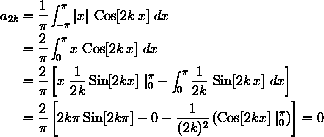 is:
is: Fourier series and general "orthogonal function expansions" are important in the study of heat flow and wave propagation as well as in pure mathematics. The reason that these series are important is that sines and cosines satisfy the "heat equation" or "wave equation" or "Laplace's equation" for certain geometries of the domain. A general solution of these partial differential equations can sometimes be approximated by a series of the simple solutions by using superposition. (Fourier series provide many interesting examples of delicately converging series because of Dirichlet's theorem 13.4 of the Mathematical Background.)
The method of computing Fourier series is quite different from the methods of computing power series.
The Fourier sine-cosine series associated with f[x] for
 is:
is:



 -periodic and continuous except for a finite number of jumps or kinks and if the value f[xj] is the midpoint of the jump if there is one at xj, then the Fourier series converges to the function at each point.
It may not converge uniformly, in fact, the approximating graphs may not converge to the graph of the function, as in Gibbs' goalposts below.
If the periodic function f[x] has no jumps (but may have a finite number of kinks, or jumps in f'[x]), then the series converges uniformly to f[x].
-periodic and continuous except for a finite number of jumps or kinks and if the value f[xj] is the midpoint of the jump if there is one at xj, then the Fourier series converges to the function at each point.
It may not converge uniformly, in fact, the approximating graphs may not converge to the graph of the function, as in Gibbs' goalposts below.
If the periodic function f[x] has no jumps (but may have a finite number of kinks, or jumps in f'[x]), then the series converges uniformly to f[x].
Convergence of Fourier series is typically weaker than the convergence of power series, as we shall see in the examples, but the weak convergence is still quite useful.
Actually, the most important kind of convergence for Fourier series is "mean square convergence,"

Convergence of Fourier series at "almost every" point was a notorious problem in mathematics, with many famous mathematicians making errors about the convergence. Fourier's work was in the early 1800s and not until 1966 did L. Carleson prove that the Fourier series of any continuous function f[x] converges to the function at almost every point. (Dirichlet's theorem uses continuity of f'[x]. Mean square convergence is much easier to work with and was well understood much earlier.)
Three basic examples of Fourier sine-cosine series are animated in the computer program FourierSeries. These are the following.


The average value of f[x] is clearly
 and can be computed as the integral
and can be computed as the integral



Show that the ak terms of the Fourier series for f[x]=|x| with odd k are

Without the absolute value the integrals of the Fourier coefficients can be computed directly, without breaking them into pieces.

 , extended to be
, extended to be
 periodic.
Notice that the average a0=0, by inspection of the graph or by computation of an integral.
Moreover,
periodic.
Notice that the average a0=0, by inspection of the graph or by computation of an integral.
Moreover,
 is an odd function, that is,
is an odd function, that is,
 , so the up areas and down areas of the integral cancel, ak=0. You can compute this from the formula.
Finally, show that
, so the up areas and down areas of the integral cancel, ak=0. You can compute this from the formula.
Finally, show that

The coefficients for the Fourier series of


Show that


 , being the integral over whole periods of the sine function.
, being the integral over whole periods of the sine function.
Finally, show



The convergence of the Fourier series for Sign[x] holds at every fixed point, but the convergence is not uniform.
In fact, the graphs of the approximations do not converge to a "square wave," but rather to "goalposts." Each approximating term has an overshoot before the jump in Sign[x] and these move to a straight line segment longer than the distance between
 . You can see this for yourself in the animation of the computer program FourierSeries.
. You can see this for yourself in the animation of the computer program FourierSeries.